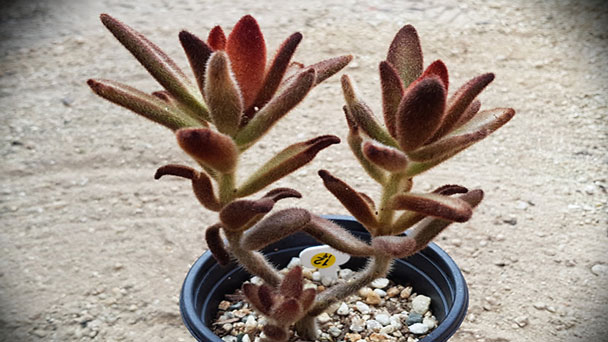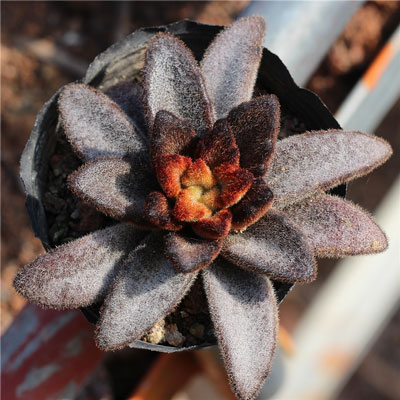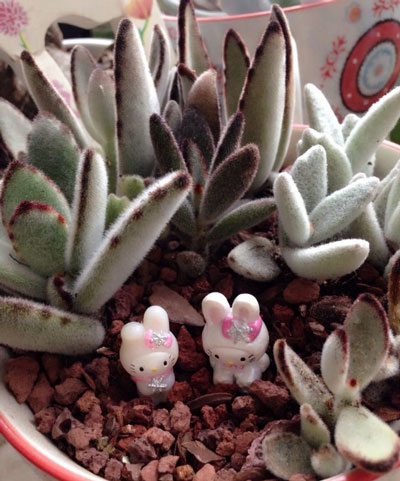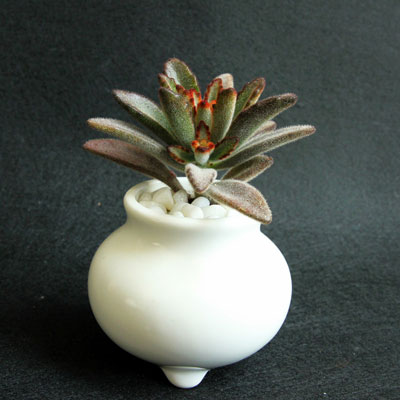Chocolate Soldier Plant (Kalanchoe Tomentosa): Succulent Grow & Care Guide
Written by Iris
Nov 08 2021

The succulents "Chocolate Soldier" (Kalanchoe Tomentosa) mainly grow in tropical areas and do not require much water. The distinctive feature is that the leaves resemble rabbit ears with fluff on the leaf surface. It is said that the fluff on the leaf surface has sun protection function. It is particularly magnificent when it blooms, it will not die after blooming, and it is very ornamental.
Propagation: It is propagated by stem cutting or by leaf cuttings in spring or summer. The trimmings resulted from shaping the plant, make ideal cuttings. Allow cuttings to dry out before repotting. These cuttings root easily in 8cm pots (3 inch) filled with a mixture of peat moss and sand. Place the pots in a warm position in bright filtered light. Water the mixture whenever the top 1-2cm (0.4-0.8 inch) dries out. The cuttings usually will produce roots in about 4 weeks. When roots have formed and new growth appears, move each young plant into a pot of standard mixture. Make sure that the pot is large enough to hold the roots. Thereafter, it should be possible to treat the plant as a mature Kalanchoe tomentosa.
When you see an offshoot starting to grow, leave it alone. It will need to grow its own root system before it can be separated from the parent plant. It will take 2 – 3 months before it has a complete root system.After 2 – 3 months, you can use a sharp knife to cut the offshoot from the parent plant. After you cut it, leave it in the same pot for a couple of days to callous over. This scar prevents pests and diseases from entering the new plant.
After the offshoot has formed its callous, you can remove the Chocolate soldier plant from its original pot and replant it into its own pot.
Because Kalanchoe tomentosa is a succulent – it stores water within its leaves – even if it is neglected for a period of time the plant will survive.
Water from the bottom or water the potting mix. Avoid getting the furry leaves of this plant wet because they'll easily rot.
Your Chocolate Soldier plant may experience root rot if you water it too frequently and it is susceptible to powdery mildew. This may cause leaves to have yellow spots or dead edges. Allow for good air circulation around your plant to avoid it and treat with a potassium bicarbonate product if you see signs of it.
Kalanchoe luciae (flapjacks Kalanchoe)- features green leaves with red tips
Kalanchoe beharensis (Felt Plant) – triangular leaves with bronze and silver colors
Kalanchoe blossfeldiana (Flaming Katy) – includes red, orange, pink, or yellow flowers

How to Grow Chocolate Soldier Plant (Kalanchoe Tomentosa)Chocolate Soldier Plant Propagation with Leaf CuttingsChocolate Soldier Plant Propagation with DivisionHow to Care for Chocolate Soldier Plant (Kalanchoe Tomentosa)Chocolate Soldier Plant Light CareChocolate Soldier Plant Soil CareChocolate Soldier Plant WateringChocolate Soldier Plant Temperature & Humidity CareChocolate Soldier Plant FertilizerChocolate Soldier Plant PruningChocolate Soldier Plant Pests & Diseases CareVarieties of Chocolate Soldier Succulent (Kalanchoe Tomentosa)Chocolate Soldier Plant Care FAQ Is Chocolate Soldier Plant Poisonous?Why are My Chocolate Soldier Plant leaves turning brown?Will my Chocolate Soldier Plant bloom?
How to Grow Chocolate Soldier Plant (Kalanchoe Tomentosa)
Chocolate Soldier Plant Propagation with Leaf Cuttings
Chocolate Soldier plant Leaf cuttings can be taken and planted in new soil during spring. Give the leaf-cutting a week of drying out before re-potting, then they are expect to begin rooting within 4 weeks.Propagation: It is propagated by stem cutting or by leaf cuttings in spring or summer. The trimmings resulted from shaping the plant, make ideal cuttings. Allow cuttings to dry out before repotting. These cuttings root easily in 8cm pots (3 inch) filled with a mixture of peat moss and sand. Place the pots in a warm position in bright filtered light. Water the mixture whenever the top 1-2cm (0.4-0.8 inch) dries out. The cuttings usually will produce roots in about 4 weeks. When roots have formed and new growth appears, move each young plant into a pot of standard mixture. Make sure that the pot is large enough to hold the roots. Thereafter, it should be possible to treat the plant as a mature Kalanchoe tomentosa.
Chocolate Soldier Plant Propagation with Division
An easier way to propagate chocolate soldier plant is through offshoots. Offshoots are clones of the parent plant. They are baby plants that grow around the base of the parent plant.When you see an offshoot starting to grow, leave it alone. It will need to grow its own root system before it can be separated from the parent plant. It will take 2 – 3 months before it has a complete root system.After 2 – 3 months, you can use a sharp knife to cut the offshoot from the parent plant. After you cut it, leave it in the same pot for a couple of days to callous over. This scar prevents pests and diseases from entering the new plant.
After the offshoot has formed its callous, you can remove the Chocolate soldier plant from its original pot and replant it into its own pot.

How to Care for Chocolate Soldier Plant (Kalanchoe Tomentosa)
Chocolate Soldier Plant Light Care
Chocolate Soldier needs a full sun and cool, dry environment, resistance to semi-shade, fear of waterlogging, and avoiding hot and humid weather. It has the habit of growing in the cold season and dormant in high temperature in summer. Every year from autumn to summer of the next year is the growing season of the plant (the environment of Flower friends is different, the growing season also has length). When we grow and care for chocolate soldiers, if the light is not enough, the plant is easy to grow unevenly, and the distance between the leaves will be longer, making the plant type loose, the stem will become very fragile, the leaves will be elongated, and the color will become pale. Chocolate Soldier, on the other hand, does not grow too slowly. A plant that grows in full sunlight is short and stout, with a relatively compact arrangement of leaves.Chocolate Soldier Plant Soil Care
Since kalanchoe tomentosa chocolate soldier plants are prone to root rot, especially when left sitting on wet soil for too long, usage of cactus and succulent potting mix that has good drainage capabilities is highly recommended. This should avoid any problems to occur to your furry friend due to overwatering.Chocolate Soldier Plant Watering
Only water Kalanchoe tomentosa Chocolate Soldier plants once the soil has become dry and then soak the soil, but do not leave water in the bottom tray. During the winter this plant needs less water.Because Kalanchoe tomentosa is a succulent – it stores water within its leaves – even if it is neglected for a period of time the plant will survive.
Water from the bottom or water the potting mix. Avoid getting the furry leaves of this plant wet because they'll easily rot.
Chocolate Soldier Plant Temperature & Humidity Care
Temperatures between 15-23ºC (60-75ºF) are advised. Like most plants, Kalanchoe tomentosa will benefit from good ventilation, but should not be exposed to prolonged draughts. Normal room humidity is fine and it may also tolerate dry air.Chocolate Soldier Plant Fertilizer
Since Chocolate soldier plants are desert plants, they can still flourish without fertilizing them. But if you do give them some feeding, make sure to do it during their growing season, which usually happens in Spring until the end of Summer using a diluted liquid succulent fertilizer.Chocolate Soldier Plant Pruning
If your chocolate soldier plant starts looking leggy, with long, spindly stems, cut them back to maintain a roughly rounded shape. You can prune whenever needed, also removing dead leaves or any that appear diseased or infested with insects.Chocolate Soldier Plant Pests & Diseases Care
Chocolate Soldier plants may suffer from all the usual pests that bother houseplants, mealybugs, aphids, and brown scale are the most common. These can be removed by cleaning the leaves with a cotton swab or rag dipped in rubbing alcohol.Your Chocolate Soldier plant may experience root rot if you water it too frequently and it is susceptible to powdery mildew. This may cause leaves to have yellow spots or dead edges. Allow for good air circulation around your plant to avoid it and treat with a potassium bicarbonate product if you see signs of it.

Varieties of Chocolate Soldier Succulent (Kalanchoe Tomentosa)
Kalanchoe marnieriana (Marnier's Kalanchoe) – rounded blue-green leaves that resemble clam shellsKalanchoe luciae (flapjacks Kalanchoe)- features green leaves with red tips
Kalanchoe beharensis (Felt Plant) – triangular leaves with bronze and silver colors
Kalanchoe blossfeldiana (Flaming Katy) – includes red, orange, pink, or yellow flowers

Chocolate Soldier Plant Care FAQ
Is Chocolate Soldier Plant Poisonous?
According to the ASPCA (American Society for the Prevention of Cruelty to Animals), chocolate soldier plant is toxic for both cats and dogs. If they eat it, they will experience vomiting and diarrhea and occasionally an abnormal heart rhythm. It's probably better not to grow this plant if you have pets.Why are My Chocolate Soldier Plant leaves turning brown?
They may just be at the end of their lifespan. New leaves will continue to grow out of the Chocolate Soldier plant's main stem while older leaves at the plant's outer edges die off. You can trim them off with clippers or scissors.Will my Chocolate Soldier Plant bloom?
It is rare for Chocolate Soldier plants that are grown as houseplants to bloom. If you are growing your plant outside, you may see small tubular flowers during the growing season. In general, these plants are grown for their interesting leaves rather than their flowers.
Latest Updated
- Benefits of Bugleweed - 7 Science-backed Health Benefits
- Bugleweed Dangers & Side Effects - Is It Poisonous?
- How to Plant Evergreen Trees - What You Should Know
- When to Plant Evergreens - Grow Guide for Evergreen Trees
- 12 Wonderful Evergreen Shrubs for Your Garden
- 12 Popular Evergreen Plants with Pictures for Beginners
- When And How To Prune A Lilac Bush Like a Pro
- How to Grow & Care for Lilac Vine (Hardenbergia Violacea)
- Japanese Lilac Tree (Syringa Reticulata) Care & Propagation Guide
- Shumard Oak Pros and Cons - What to Know
Popular Articles
- Winter maintenance of Antirrhinum Majus
- How to Grow Terminalia Mantaly Tree
- How to Grow and Care for Crossostephium Chinense
- How to grow Antirrhinum Majus in spring
- Peristeria Elata (Dove Orchid) Profile: Info & Care Guide
- Underwatered Snake Plant (Sansevieria Trifasciata) - Signs And How To Fix
- How to Care for Brazilian Jasmine Plant (Mandevilla Sanderi)
- How to Grow & Care for Graptopetalum Purple Delight in Summer
- Rosa Chinensis (China Rose): Plant Growing & Care Tips
- How to Care for Baby Sun Rose (Aptenia Cordifolia)